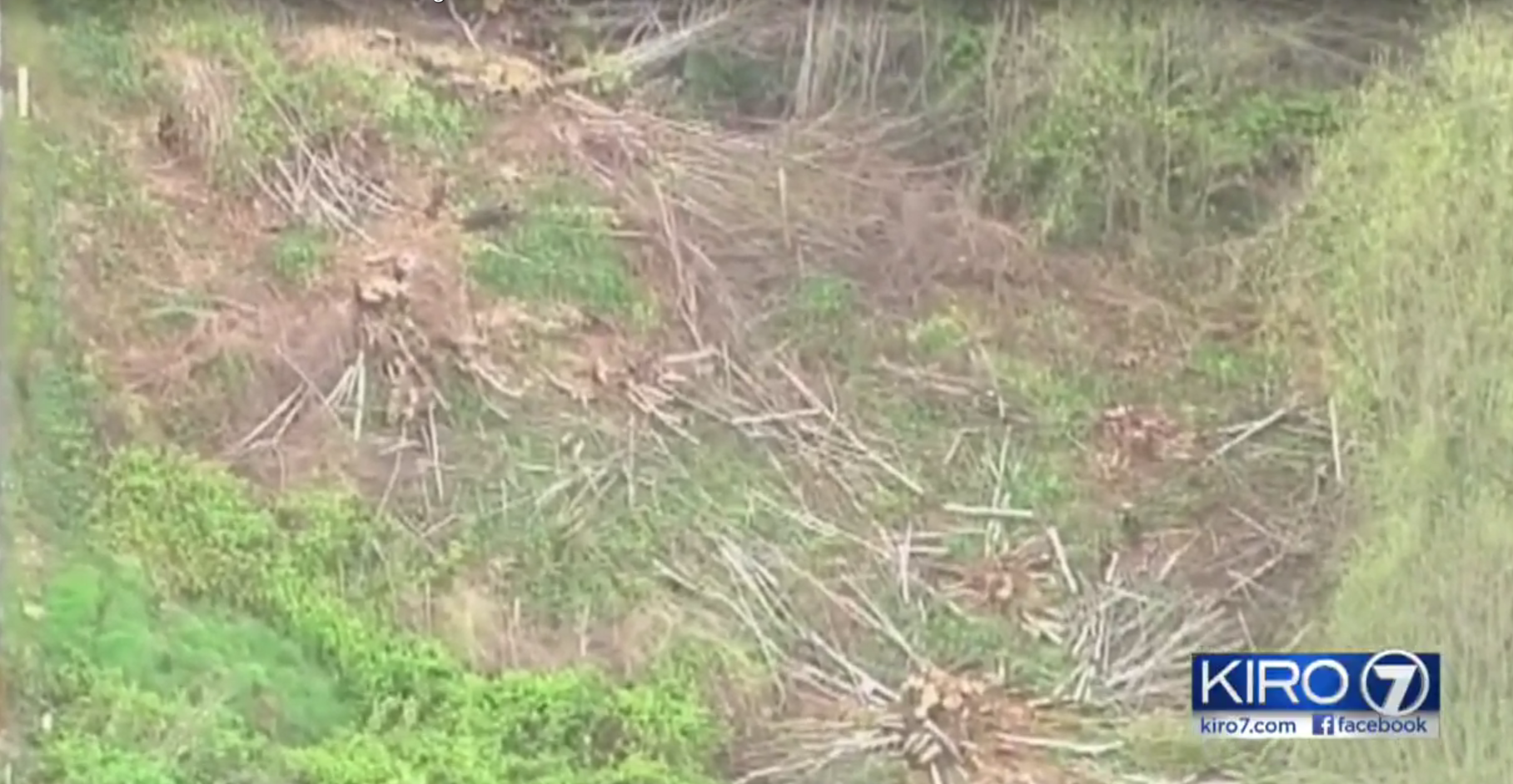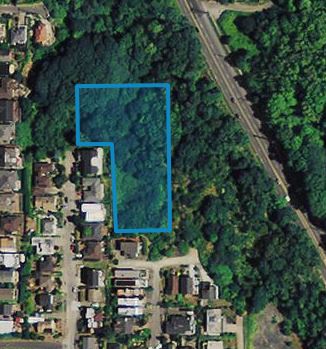Illegal Tree Cutting, Update on 23rd Ave, and Secure Scheduling Discussion

Illegal Tree Cutting in the Duwamish Head Greenbelt
Last Saturday I asked City Attorney Pete Holmes to join me in visiting the Duwamish Head Greenbelt, where I had learned that morning that over 150 trees were illegally removed from Parks and SDOT property. The tree cutting is dramatic; those who call it a clear-cut are not exaggerating. The destruction of trees saddened me—these trees belong to all of us.
This took place west of SW Admiral Way up the hill from the West Seattle Bridge, on a steep slope in a potential landslide zone. This is a public safety threat: SW Admiral Way is a major arterial with 25,000 trips per day. Further, this location is a Seattle Green Partnership area, meaning it is in an area targeted by the City and our partners for restoration work because of both its ecological importance and vulnerability.
ecological importance and vulnerability.
The City Attorney’s Office said that restoration costs are expected to be at least several hundred thousand dollars, and could involve felony charges. I have been assured by the City Attorney that both criminal and civil sanctions are on the table for the responsible parties.
The sanctions must be significant enough to deter this kind of activity in the future. Penalties need to be strong enough so that those with financial means don’t see illegal tree cutting as a cost-effective way to increase their views and property values (there is an unfortunate precedent in the Mount Baker neighborhood, dating to 2002, when the King County Prosecutor’s Office opted not to purse felony charges).
I want to be sure the valuation of the trees fully takes into account the role the trees play in maintaining soil stability in an environmentally critical area by absorbing water, thus lessening the risk of landslides onto a major arterial. Further, trees maintain air quality by absorbing carbon —an important issue in West Seattle and South Park, which sit adjacent to SODO and the Duwamish industrial area. The Green Cities Research Alliance 2012 Report, Seattle’s Forest Ecosystem Values, has additional information about Seattle’s trees, estimated to have a replacement value of $4.9 billion—an important capital asset.
Portland’s Tree Code allows for consideration of “the benefits, economic, financial or otherwise, accruing or likely to accrue as a result of the violation” in setting a civil penalty of up to $1,000 per day. This is worth examining. We’ve learned that, in response to a constituent request to increase property value assessments to reflect view property status, the King County Assessor has sent division directors to visit the site and will be sending an appraisal team shortly.
The sequence of events appears to be as follows: on January 15, a community member e-mailed the SDOT arborist to report the activity in progress. On February 5, a lawyer representing a client sent a letter to the Parks Superintendent to disclose the damage. It appears there may be other parties involved. The letter claims the client was involved in only a portion of the tree cutting.
On February 12, nearly a month later, SDOT and Parks employees went to the site, and according to the City Attorney’s statement, “found that the tree cutting had been extensive and may have occurred in stages over time.” Non-city tree experts believe this is not the first time these trees had been cut.
Constituents have sent me a number of suggestions. More than one has suggested replacing the cut trees with the largest trees possible. Others suggest installing private view blocking signage until trees have grown back. Jimmy Malecki, a Seattle native now living in Australia, noted that this is included as an option in the Policy re: Vegetation Vandalism on Public Land in Tweed, Australia.
The City Attorney is requesting that anyone with information to share contact the Seattle Police Department at 206-625-5011. He also requests that people refrain from disturbing evidence and the scene and respect the privacy of nearby residents as the investigation proceeds.
The Nature Consortium, headquartered in West Seattle, does restoration work in partnership with the Seattle Green Partnership. They sent a statement that reads, in part:
Nature Consortium has been engaging thousands of Seattle community members as volunteers and the volunteers at our organization alone have contributed many tens of thousands of hours working to restore Seattle’s urban forests. The crime that has been committed in the Duwamish Head Greenbelt is…an audacious theft and destruction of one of the most precious resources we own as a community. The trees clear cut were taken from every Seattle resident. Every tree standing in the Greenbelt represents a healthier environment for every person in our community. Every tree standing represents a more livable city for everyone. Every tree standing represents cleaner air and cleaner water. Every tree standing represents more sustainable habitats for plants and animals alike.
Merica Whitehall, Executive Director
Update on 23rd Avenue Business Stabilization Plan
During the February 23rd Civil Rights, Utilities, Economic Development, and Arts (CRUEDA) Committee the Office of Economic Development (OED) and Seattle Department of Transportation (SDOT) discussed the creation of a new $650,000 Business Stabilization Fund to mitigate impacts from the rechannelization project on small businesses and the request of the Council to help address those needs. The Stabilization Fund is comprised of funds from the Community Development Block Grant and New Market Tax Credit funds. Due to legal restrictions these were the primary fund sources considered.
Based on the needs assessments conducted by OED, the cap for funds is $25,000 to go towards outstanding debt, recouping expenses, and sustain the businesses through construction. As of March 28th, 22 businesses are eligible for direct financial assistance. The deadline for submitting completed documentation is on April 29th.
To minimize impacts to businesses, SDOT has newly rented parking for their construction vehicles as well as erected barriers to delineate sidewalks and pedestrian areas. They are discussing with the community the potential overlap in the timeline for the next stages of work to be completed in Zone 2 and Zone 3. The Race and Social Justice Toolkit analysis for this project is still in process with a goal for completion by mid-April.
A question for on-going discussion is how can the City help small business owners withstand construction that comes with redevelopment or City capital projects like those funded by the Move Levy? Through our “Only in Seattle” program OED actively supports local, small businesses throughout Seattle. This program works with in business districts throughout the City, including areas at risk of displacement, including SE Seattle, Chinatown/ID, and now includes the Central Area. OED plans to initiate a citywide commercial affordability advisory committee to engage in issues, and the Central Area will be a part of this effort. As part of the CRUEDA committee work plan we will be monitoring and examining the implementation of the “Only in Seattle” program.
Secure Scheduling Discussion
Last Tuesday, March 22nd I hosted the first CRUEDA Committee Secure Scheduling stakeholder meeting. I anticipated that this would be a difficult conversation, and indeed it was. But I think that’s a good thing because often important issues are also difficult. Prior to this meeting, the Mayor’s office convened two larger group discussions – with employers and employees – to address the topic of employer coverage; or to which businesses should the policy apply? For the CRUEDA meeting I asked three representatives from each of the two groups to convey their respective group’s viewpoints on the topic of employer coverage.
We heard from employers and business that they believe there is not sufficient local data upon which to develop public policy and that they would like a longer timeline to discuss the issues (currently the plan is to bring forward a draft Council Bill in July). Worker advocates expressed that this issue is an emergency, and that there should be a focus on the retail and food service industry specifically fast food, coffee, formula retail (otherwise known as chain stores or stores with multiple locations, standardized features, and a recognizable appearance) and businesses with 250 plus employees. Councilmember O’Brien got to the heart of the issue when he said that while there may be challenges for businesses, the question he asks is: why is business desire for scheduling flexibility resulting in burdens that are borne solely by workers?
I am happy that business leaders and worker advocates are coming to the table. My goal is to give them as much direct access to Councilmembers in each of the discussions over the next several CRUEDA committee meetings where the elements of this policy will be discussed.
Our next CRUEDA committee meeting is on April 12th. We will continue this conversation with the focus being in this meeting on the issues of a. what is an adequate amount of advanced schedule notice and b. predictability pay to address large variations in weekly pay resulting when workers have a significant percentage of their hours scheduled as on-call or are often sent home before the end of a shift.
Posted: March 30th, 2016 under Councilmember Herbold, Labor Standards, Parks and Recreation, Public Health, Transportation, Trees
Tags: Labor Standards, SDOT, secure scheduling, trees

